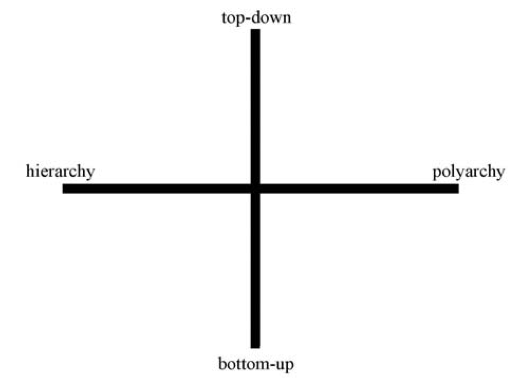Four Quadrants: Difference between revisions
Jump to navigation
Jump to search
| Line 15: | Line 15: | ||
Professor Zittrain uses precise (sometimes unconventional) definitions of these terms: | Professor Zittrain uses precise (sometimes unconventional) definitions of these terms: | ||
* | *'''Top-down''': systems in which “there is a separation between those who make the rules and those who live under them . . . .” | ||
* | *'''Bottom-up''': systems where the rules can come from any person without separation between the people who make the rules and people who live under them. | ||
* | *'''Hierarchy''': “a system for which there is no alternative, either because it does not exist, because it would be too costly, or because law precludes it.” | ||
* | *'''Polyarchy''': being able to choose between multiple regimes or systems. | ||
== Proposals == | == Proposals == | ||
Revision as of 18:09, 19 December 2010
Introduction
Terms
Definitions
The Four Quadrants
In his article, The Fourth Quadrant, Professor Zittrain develops a four quadrant framework for thinking about the Internet. This framework looks at two criteria: (1) how generative something is, and (2) how singular it is.
The generativity of a phenomena is assessed on a scale from entirely “top-down” to entirely “bottom-up.” The range of singularity runs from “hierarchy” to “polyarchy.” This is captured in the following chart from the article:
Professor Zittrain uses precise (sometimes unconventional) definitions of these terms:
- Top-down: systems in which “there is a separation between those who make the rules and those who live under them . . . .”
- Bottom-up: systems where the rules can come from any person without separation between the people who make the rules and people who live under them.
- Hierarchy: “a system for which there is no alternative, either because it does not exist, because it would be too costly, or because law precludes it.”
- Polyarchy: being able to choose between multiple regimes or systems.
